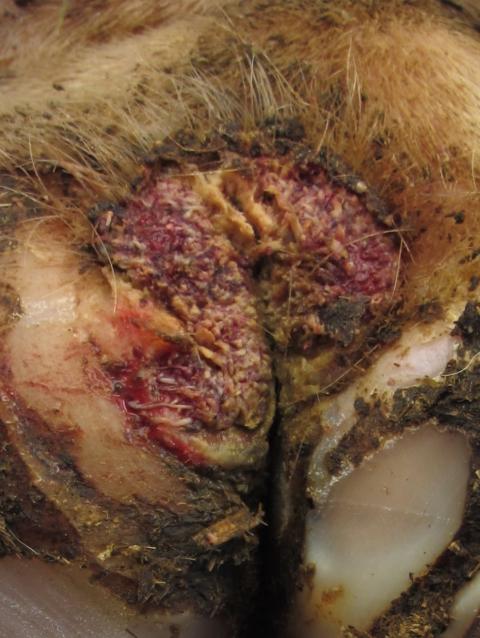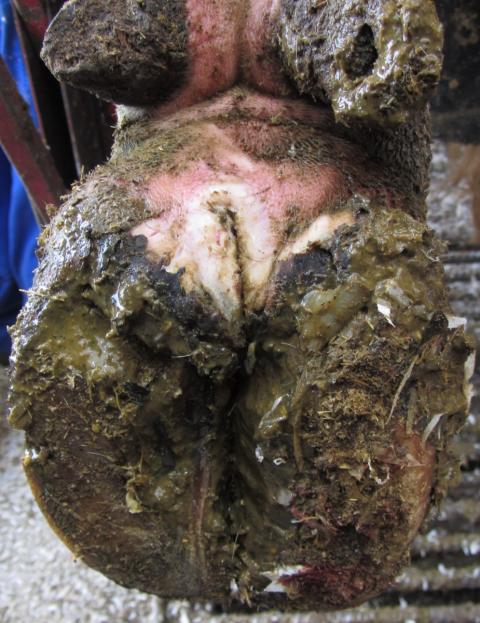By Sara Pedersen BSc(Hons) BVetMed CertCHP DBR MRCVS RCVS Specialist in Cattle Health and Production, Farm Dynamics Ltd, Cowbridge, Vale of Glamorgan
Even if digital dermatitis (DD) isn’t at the fore-front of the lameness problem on a farm, it is almost always lurking somewhere in the background. It is a highly infectious and painful condition and is often referred to as ‘mastitis of the foot’ due to the importance of the environment in its control.
What is Digital Dermatitis?
DD is caused by a group of bacteria called treponemes. These are very active and mobile, allowing them to move rapidly within a wet environment making them highly contagious in the right conditions. Rather than staying on the surface, they are invasive and can burrow deep into the skin creating a chronic infection. There are a number of specific strains of treponeme that have been found to cause DD, all of which vary in their severity. If multiple strains are present then the lesion is likely to be more severe than if just one strain is involved.
Keeping DD out of the herd
If you are lucky enough not to have DD on your farm it is important to prevent it from entering the herd, therefore good biosecurity is paramount. Purchased stock are the greatest risk when it comes to introducing infection. Since individuals can act as carriers without necessarily showing signs of infection, it is important that cattle are purchased from DD free herds in order to protect your herd’s status. Simply selecting cattle not showing signs of DD within an infected herd is not a guarantee that they won’t carry infection with them.
When ‘clean’ cattle are being transported it is important to ensure that they aren’t mixed with cattle from herds either DD or with an unknown DD status and all trailers must be thoroughly cleaned and disinfected before use.
Even if you have DD on your farm it is important to remember that there is the potential for purchased stock to bring in new strains which can result in more severe infections and outbreaks.
The Different Faces of DD:
There are many different stages to DD infections and even within the different stages the lesions can vary in their appearance. Lesions mostly occur on the underside of the foot either on the skin adjacent to the interdigital cleft or on the skin-horn junction of the heels. The hind feet are more commonly affected and it is usual for both hind feet to have lesions at the same time. Occasionally DD can be found around the dew claws or on the front of the foot in between the claws. It has also been found to infect claw horn lesions including white line disease or sole ulcers.
When it comes to the development of DD, there are multiple risk factors, however, good hygiene is key. Slurry not only provides a route of transmission from cow to cow but is also very irritating on the soft skin of the heel, damaging its integrity and leaving it more at risk of infection. If feet are heavily contaminated it also creates the perfect low oxygen environment in which DD can thrive.
Under the right conditions lesions will start to develop. At this early (subclinical) stage the lesions are <2cm in diameter, greyish in colour and are not generally painful. Within a few days, if not treated, these develop into the classic ulcerative ‘active’ stage (Photo One) which is typically circular or oval in shape and has a strawberry-like appearance, with clear borders and a distinctive odour. Whilst these lesions are painful to the touch, cows do not always show signs of lameness making them difficult to spot without active surveillance, which can easily be carried out during milking. Unless these lesions are treated early with topical antibiotics resulting in the healing stage (Photo Two) the bacteria can bury deep into the skin layers where they wall themselves off forming chronic inactive lesions (Photo Three), which can recur at a later stage. These lesions appear as thickening of the skin around the interdigital cleft and are generally not painful. However, DD remains deep inside the lesion and will recur in the right conditions. It is these lesions (Photo Four) that are the main drivers behind outbreaks and reducing their recurrence is one of the key aims of footbathing.
The DD Cycle:
The dynamics of the different DD stages can be thought of as a cycle (Figure One). However, it is not simply a case of one stage logically following on to the next until the cycle is complete. Lesions may move back and forth between certain stages depending on the prevention and treatment protocols that are in place.
The key to breaking the cycle is threefold:
- Improved hygiene to reduce the risk of the new infections occurring.
- Early effective topical treatment of new active lesions.
- Footbathing to prevent the recurrence of chronic inactive lesions which are the key drivers of outbreaks.
Despite the contagious nature of DD and the many risk factors contributing to infection, it is possible to minimise its incidence through implementation of a robust control plan. Footbathing is a key component for the control of infection and will be discussed in detail in the next part of this DD series.
Figure One: The DD Cycle
Photo One: Active stage
Photo Two: Healing stage with scab covering the lesion
Photo Three: Chronic inactive lesion
Photo Four: Recurring chronic lesion
Click here to download a PDF version of this article.





